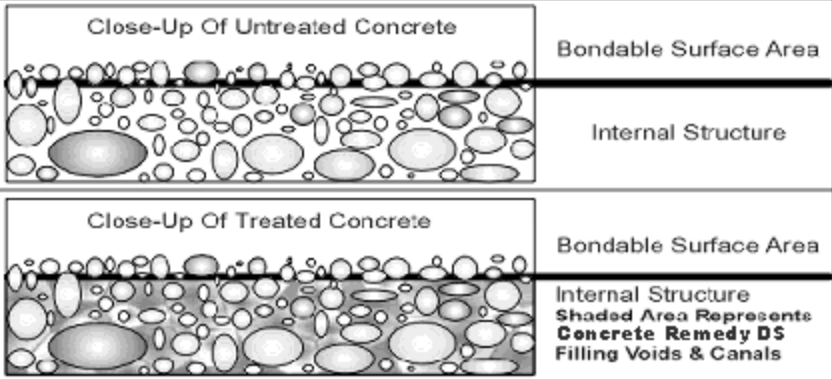Concrete Remedy Deep Seal
How Concrete Remedy Deep Seal Works
Concrete Remedy DS reacts with the alkali in the moisture on the surface of the voids and particulate to form a sticky gel which is forced by capillary (and an attraction to dampness), into the voids and canals that exist beneath the concrete. Concrete Remedy DS has an affinity for moisture, this facilitates it floating along through the voids and canals. As it does so, it encounters more alkali-rich moisture and forms more gummy gel, coating the walls of the larger voids and canals, completely filing smaller ones (shady areas in the bottom section of graphic below). This process repeats itself until the concrete is permanently sealed. Yet, Concrete Remedy DS allows the concrete to breathe. As the silicate solution penetrates the concrete surface, the soluble SiO2 species react with portlandite or calcium hydroxide, (Ca(OH)2) and/or Ca2+ in the pore solution to form calcium silicate hydrate (C-S-H).CSH is the space filling glue phase created when the cement in concrete is hydrated with water. Portlandite is an undesirable phase in concrete because it precipitates as platelets near aggregates. The result is a porous paste/aggregate interface that increases concrete permeability and reduces compressive strength. Portlandite is also subject to acid attack and carbonation. Also known as Calcium hydroxide, traditionally called slaked lime or hydrated lime, it is a chemical compound with the chemical formula Ca(OH)2.In contrast to portlandite, calcium hydroxide Ca(OH)2, C-S-H is the desirable, space-filling glue phase. Applying Deep Seal causes C-S-H to replace portlandite. The results are: decreased permeability, less susceptibility to acid attack and carbonation enhanced abrasion resistance (that is, dust-proofing), chemical resistance, and durability of the concrete surface. Here’s a “picture” of what Deep Seal does in concrete by forming C-S-H:
Specifications | |||||||||||||||||||||||||||||||||||||||||||||||||||||||||||||||||||||||||||||||||||||||||||||||||||
|---|---|---|---|---|---|---|---|---|---|---|---|---|---|---|---|---|---|---|---|---|---|---|---|---|---|---|---|---|---|---|---|---|---|---|---|---|---|---|---|---|---|---|---|---|---|---|---|---|---|---|---|---|---|---|---|---|---|---|---|---|---|---|---|---|---|---|---|---|---|---|---|---|---|---|---|---|---|---|---|---|---|---|---|---|---|---|---|---|---|---|---|---|---|---|---|---|---|---|---|
Dilutent | Use As Supplied | ||||||||||||||||||||||||||||||||||||||||||||||||||||||||||||||||||||||||||||||||||||||||||||||||||
Freeze Temperature | 32 Degrees F | ||||||||||||||||||||||||||||||||||||||||||||||||||||||||||||||||||||||||||||||||||||||||||||||||||
Freeze Harm | None | ||||||||||||||||||||||||||||||||||||||||||||||||||||||||||||||||||||||||||||||||||||||||||||||||||
Boiling Point | 230 Degrees F | ||||||||||||||||||||||||||||||||||||||||||||||||||||||||||||||||||||||||||||||||||||||||||||||||||
Coverage/Gallon | 150-200 sq. ft. | ||||||||||||||||||||||||||||||||||||||||||||||||||||||||||||||||||||||||||||||||||||||||||||||||||
Shelf Life | Infinite | ||||||||||||||||||||||||||||||||||||||||||||||||||||||||||||||||||||||||||||||||||||||||||||||||||
Solvent For Clean Up | Water | ||||||||||||||||||||||||||||||||||||||||||||||||||||||||||||||||||||||||||||||||||||||||||||||||||
Color | None | ||||||||||||||||||||||||||||||||||||||||||||||||||||||||||||||||||||||||||||||||||||||||||||||||||
Odor | None | ||||||||||||||||||||||||||||||||||||||||||||||||||||||||||||||||||||||||||||||||||||||||||||||||||
Toxicity | NonToxic | ||||||||||||||||||||||||||||||||||||||||||||||||||||||||||||||||||||||||||||||||||||||||||||||||||
Flammability | None | ||||||||||||||||||||||||||||||||||||||||||||||||||||||||||||||||||||||||||||||||||||||||||||||||||
Fumes | None | ||||||||||||||||||||||||||||||||||||||||||||||||||||||||||||||||||||||||||||||||||||||||||||||||||
Organic Properties | Negligible | ||||||||||||||||||||||||||||||||||||||||||||||||||||||||||||||||||||||||||||||||||||||||||||||||||
Environmental Hazards | None | ||||||||||||||||||||||||||||||||||||||||||||||||||||||||||||||||||||||||||||||||||||||||||||||||||
Polymerized Content | Excellent | ||||||||||||||||||||||||||||||||||||||||||||||||||||||||||||||||||||||||||||||||||||||||||||||||||

Product Advantages
- Solves Problems At The Source
- Never Needs Reapplication
- Is Nontoxic, Odorless, and Safe
- Does Not Alter Color or Texture
- Permanently Waterproofs and Retards Penetration of Grease, Oil, and Acids
- Increases Success of Any Top Coating
- Retards Pitting, Dusting, and Rutting
- Cures Uniformly
- Permanently Densifies and Hardens Surfaces
- Can Be Painted Over
- An Alkali Activated Chemical Penetrating Masony Stabilizer
- Outperforms Typical Sealers
- Extends The Life of Surfaces
Product Uses
- Shotcrete, Stucco, Mortar, Anything Cement
- With Surface Sealers - Every Product That Can Be Applied To Concrete Will Perform Better When Used With Concrete Remedy DS
Limitations
Not for use on glass. ETCHING OF THE GLASS WILL OCCUR. Clean Concrete Remedy DS off of glass immediately with water to prevent etching.
Concrete Remedy DS should never be applied if the surface temperature is below or going to drop below freezing.
Concrete Remedy DS is not intended to be applied over painted surfaces, nor is it intended to seal visible cracks larger than about .75 mm.
Concrete Remedy DS is best applied to damp or moist surfaces, although it will work as intended when applied to dry concrete.
our promise & disclaimer
We believe this information to be true to the best of our knowledge. Our products are of the highest quality and uniform within manufacturing tolerances. Since no direct control is exercised over product use, no warranty, expressed or implied, is made as to the suitability of products for a particular use or as to the effect of such use, and no liability is assumed, directly or indirectly. In the event products received were defective at point of manufacture, replacement will be made at no cost to purchaser.
